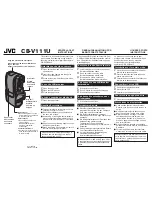
1. Plug the AC cord directly into the AC outlet. Do not use an
isolation transformer for this check.
2. Connect "A" to exposed metallic part on the set. And
connect "B" to a good earth ground, as shown in Figure 1.
3. Use an AC voltmeter, with 1 k
W
/V or more sensitivity, to
measure the potential across the resistor.
4. Check each exposed metallic part, and measure the
voltage at each point.
5. Reverse the AC plug in the AC outlet and repeat each of the
above measurements.
6. The potential at any point should not exceed 0.75 V RMS.
A leakage current tester (Simpson Model 229 or equivalent)
may be used to make the hot checks, leakage current must
not exceed 1/2 mA. In case a measurement is outside of
the limits specified, there is a possibility of a shock hazard,
and the equipment should be repaired and rechecked
before it is returned to the customer.
Figure 1
3 SAFETY PRECAUTIONS
3.1. GENERAL GUIDELINES
1. IMPORTANT SAFETY NOTICE
There are special components used in this equipment which are important for safety. These parts are marked by
in the
Schematic Diagrams, Circuit Board Layout, Exploded Views and Replacement Parts List. It is essential that these critical parts
should be replaced with manufacturer’s specified parts to prevent X-RADIATION, shock fire, or other hazards. Do not modify
the original design without permission of manufacturer.
2. An Isolation Transformer should always be used during the servicing of AC Adaptor whose chassis is not isolated from the AC
power line. Use a transformer of adequate power rating as this protects the technician from accidents resulting in personal injury
from electrical shocks. It will also protect AC Adaptor from being damaged by accidental shorting that may occur during
servicing.
3. When servicing, observe the original lead dress. It a short circuit is found, replace all parts which have been overheated or
damaged by the short circuit.
4. After servicing, see to it that all the protective devices such as insulation barriers, insulation papers shields are properly
installed.
5. After servicing, make the following leakage current checks to prevent the customer from being exposed to shock hazards.
3.2. LEAKAGE CURRENT COLD CHECK
1. Unplug the AC cord and connect a jumper between the two prongs on the plug.
2. Measure the resistance value, with an ohmmeter, between the jumpered AC plug and each exposed metallic cabinet part on
the equipment such as screwheads, connectors, control shafts, etc. When the exposed metallic part has a return path to the
chassis, the reading should be between 1M
W
and 5.2M
W
. When the exposed metal does not have a return path to the chassis,
the reading must be infinity.
3.3. LEAKAGE CURRENT HOT CHECK (See Figure 1)
8
PV-GS65PP
Summary of Contents for PV-GS65PP
Page 11: ...6 HOW TO RECYCLE THE LITHIUM BATTERY 11 PV GS65PP ...
Page 14: ...Fig D3 Fig D4 Fig D5 Fig D6 14 PV GS65PP ...
Page 15: ...Fig D7 Fig D8 Fig D9 Fig D10 15 PV GS65PP ...
Page 16: ...Fig D11 Fig D12 Fig D13 Fig D14 16 PV GS65PP ...
Page 17: ...Fig D15 Fig D16 Fig D17 Fig D18 17 PV GS65PP ...
Page 18: ...Fig D19 Fig D20 Fig D21 Fig D22 18 PV GS65PP ...
Page 20: ...Fig M3 20 PV GS65PP ...
Page 21: ...Fig M4 Fig M5 21 PV GS65PP ...
Page 22: ...Fig M6 22 PV GS65PP ...
Page 25: ...How to use extension cables Fig T1 25 PV GS65PP ...
Page 30: ...Fig E3 Rough image of set up connection 30 PV GS65PP ...
Page 35: ...Fig D2 Fig D3 35 PV GS65PP ...
Page 84: ...PV GS65PP 84 ...
Page 92: ...PV GS65PP 92 ...
Page 111: ...17 EXPLODED VIEWS 17 1 FRAME CASING SECTION 1 111 PV GS65PP ...
Page 112: ...17 2 FRAME CASING SECTION 2 112 PV GS65PP ...
Page 113: ...17 3 LCD SECTION 113 PV GS65PP ...
Page 114: ...17 4 CAMERA LENS SECTION 114 PV GS65PP ...
Page 115: ...17 5 VCR MECHANISM SECTION 115 PV GS65PP ...
Page 116: ...17 6 PACKING PARTS ACCESSORIES SECTION 116 PV GS65PP ...









































